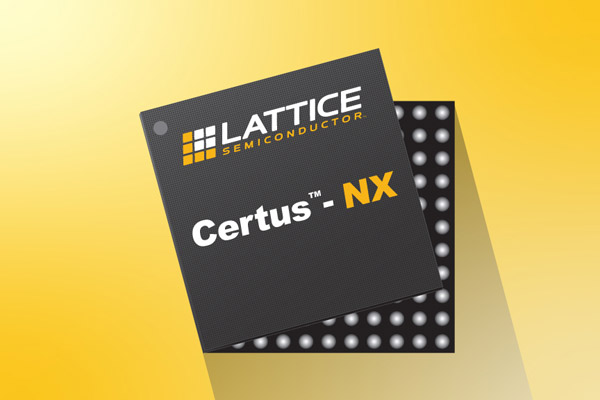 Lattice Semiconductor Corporation, the low power programmable leader, today launched the new Lattice Certus™-NX family of FPGAs. The devices lead the general-purpose FPGA market in I/O density, delivering up to twice the I/O density per mm2 in comparison to similar competing FPGAs, and provide best-in-class power savings, small size, reliability, instant-on performance, and support fast PCI Express (PCIe) and Gigabit Ethernet interfaces to enable data co-processing, signal bridging, and system control. Certus-NX FPGAs target a range of applications, from data processing in automated industrial equipment to system management in communications infrastructure. The Certus-NX devices are the second family of FPGAs developed on the Lattice Nexus™ platform, the industry’s first low power FPGA platform using 28 nm FD-SOI process technology. With the launch of Certus-NX, Lattice marks the release of the second device family developed under Lattice’s new product development strategy in just six months.
Lattice Semiconductor Corporation, the low power programmable leader, today launched the new Lattice Certus™-NX family of FPGAs. The devices lead the general-purpose FPGA market in I/O density, delivering up to twice the I/O density per mm2 in comparison to similar competing FPGAs, and provide best-in-class power savings, small size, reliability, instant-on performance, and support fast PCI Express (PCIe) and Gigabit Ethernet interfaces to enable data co-processing, signal bridging, and system control. Certus-NX FPGAs target a range of applications, from data processing in automated industrial equipment to system management in communications infrastructure. The Certus-NX devices are the second family of FPGAs developed on the Lattice Nexus™ platform, the industry’s first low power FPGA platform using 28 nm FD-SOI process technology. With the launch of Certus-NX, Lattice marks the release of the second device family developed under Lattice’s new product development strategy in just six months.
“Certus-NX delivers unique and innovative capabilities that set it apart,” said Linley Gwennap, Principal Analyst at The Linley Group. “Compared to competing FPGAs of similar gate counts, Lattice offers a much smaller package, greater I/O density, and lower power.”
“Thanks to innovations at the system, architecture, and circuit level in our Lattice Nexus development platform, we are releasing new products at a faster pace and giving our customers more options to choose from as they evaluate the performance and power needs of their applications,” said Gordon Hands, Director of Product Marketing, Lattice Semiconductor. “Certus-NX has clearly reset expectations for what developers should look for in general-purpose FPGAs by providing a compelling blend of parallel processing performance and flexible I/O support that enables creative new device designs.”
Technology trends like industrial automation and 5G have developers across markets looking to add processing and connectivity to applications that operate at the network Edge. To successfully support these trends, devices require low power processing hardware with support for popular interfaces like PCIe and Gigabit Ethernet. Device developers also need easy-to-use development platforms from a single source that provide the hardware, software, and IP they need to get products to market quickly.
“As an FPGA-centric design house, we’re seeing increasing adoption of serial protocols like PCIe and Gigabit Ethernet for chip-to-chip connectivity in many end applications, including 5G and IoT systems,” said Sanjeev Kumar, CEO, Logic Fruit Technologies. “The latest generation of FPGAs by Lattice, Certus-NX, supports these standards and provides a high density of I/Os while keeping power consumption and overall device footprint in check. These FPGAs will allow us to rapidly adapt to the challenging and evolving connectivity and performance needs of our customers.”
Key features of the Lattice Certus-NX FPGA family include:
- Up to 3x smaller form factor – Certus-NX FPGAs easily fit into compact designs with minimal impact on overall design footprint. For example, Certus-NX FPGAs can enable a complete PCIe solution with a size of only 36 mm2. Even when using the smallest package available in the family, Certus-NX FPGAs deliver up to twice the I/O density per mm2 in comparison to similar competing FPGAs to enable greater design flexibility and robust support for bridging applications.
- Robust I/O interfacing capability – Certus-NX developers will have access to Lattice’s extensive IP library. Notable IP blocks available on Certus-NX include:
- 5 Gbps differential I/O with performance that is up to 70 percent higher than competing FPGAs.
- 5 Gbps PCIe, 1.5 Gbps SGMII, and 1066 Mbps DDR3. Developers can test these IP blocks on Certus-NX development boards for the fast implementation of interfaces commonly used in Certus-NX FPGAs’ target applications.
- Strong authentication and encryption – To secure the devices’ bitstream against unauthorized access/alteration/copying, Certus-NX FPGAs support AES-256 encryption with best-in-class ECDSA authentication to protect devices throughout their lifecycles.
- Up to 4x lower power consumption – Certus-NX FPGAs use a programmable back bias to enable user-selectable high performance or low power operating modes, depending on the needs of their application. The devices can provide power consumption up to 4x lower than similar FPGAs.
- Instant-on performance – The devices also offer ultra-fast device configuration from SPI memory that is up to 12x faster than similar competing FPGAs, with individual I/Os able to configure in just 3 ms, and full-device startup in only 8-14 ms depending on device capacity.
- High reliability – Reliable performance is key for safety-critical industrial and automotive applications where devices must perform as expected to avoid damage/injury. Certus-NX FPGAs offer up to 100 times better soft-error rate (SER) performance than similar FPGAs. Certus-NX FPGAs are temperature-rated for use in industrial applications. They also support ECC and SEC in hardware.
- Ease of use/design – Certus-NX FPGAs support Lattice Radiant® software, an easy-to-use, unified FPGA design environment that integratesbest-in-class tools and features to help users develop their applications quickly and efficiently.
Lattice has already shipped sample devices to select customers. For more information, please visit http://www.latticesemi.com/Certus-NX.


